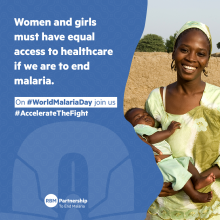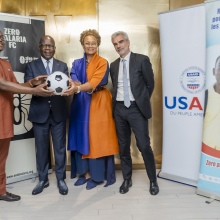Between 2001 and 2015, WHO estimates that 6.8 million lives have been saved through reductions in mortality from malaria, through improved access to effective diagnosis and treatment, as well as through preventative measures such as the use of long lasting insecticide treated nets (LLINs), indoor residual spraying (IRS) with insecticides, prophylactic chemical treatment with antimalarials, and environmental management techniques to reduce mosquito breeding sites and kill mosquito larvae. Nevertheless, despite the successes that have been achieved, the current tools will not suffice to eradicate malaria. Evolution of the malaria parasites and their mosquito hosts together with global climate change pose a threat of potential disease resurgence that could reverse progress and render current tools obsolete.
Scale-up of effective prevention, diagnosis, and treatment must go together with support for the pipeline of new potential innovations. Continued support for this research and development pipeline as well as programs to support scale-up and access therefore remain vitally important. As progress is made and the consumer markets for these products naturally shrink, ensuring the sustainability of the innovation pipeline until malaria is eradicated will remain a core priority of the global malaria community. While greater and more predictable funding is still needed in this area, 2018 has been a good year for innovation in malaria, as partners’ efforts, many years in the making, are bringing new discoveries, techniques, and technologies to the scientific community and to the marketplace.
We are fortunate in the global malaria community to have strong product development and access partnerships such as Unitaid, Medicines for Malaria Venture (MMV), Innovative Vector Control Consortium (IVCC), Innovation to Impact (I2I), Foundation for Innovative New Diagnostics (FIND), and others. Last month, we celebrated a new milestone for malaria treatment with the approval of Tafenoquine by the United States Food and Drug Administration (FDA) as a Single Exposure Radical Cure (SERC) for patients aged 16 years and older who are receiving appropriate antimalarial therapy for acute P. vivax infection – the first new treatment for relapsing malaria in 60 years. There is now a pressing need to develop a point of care, rapid test for Glucose-6-phosphate dehydrogenase (G6PD) deficiency, which is a contraindication for use.
Through the successful work of the Unitaid-funded Next Generation IRS project (NgenIRS) with IVCC, there are also now a new class of chemicals available for insecticides for the first time in 40 years. The expanded use of 3rd Generation Indoor Residual Spraying (3GIRS) products as part of insecticide resistance management strategies in Africa is now on the horizon. With two long-lasting IRS products now available, SumiShield® 50WG and Actellic® 300CS and the third, Fludora® Fusion, being in the final stages trials for WHO Prequalification, the pre-emptive annual rotation goal outlined in the Global Plan for Insecticide Resistance Management in malaria vectors (GPIRM) will soon be achievable. Developments such as these require long-term investments in research and development. To sustain and build on the gains that were achieved with the Millenium Development Goals and the scale-up of Long Lasting Insecticidal Nets (LLINs), malaria Rapid Diagnostic Tests (mRDTs), and Artemisinin Combination Therapes (ACTs), we need to invest in tomorrow’s tools today.
While innovation is crucial in the long-term battle to wipe out malaria, this does not take away from the urgent need to save the lives of those individuals who are in immediate danger and do not have time to wait for better tools. Increasing coverage of essential life-saving interventions and reaching those hard to reach communities is as crucial as ever and remains one of our biggest challenges. The next frontier for innovation in malaria is both exciting and challenging. We need to persuade governments, international organisations and the private sector to not only accelerate the latest innovations but also scale up successful prevention and treatment methods as quickly as possible to defeat malaria and, ultimately, end it for good.
Latest Blogs



